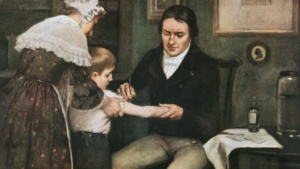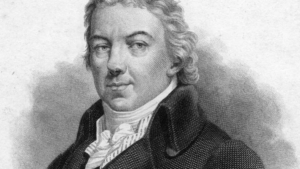Edward Jenner: The Father of Vaccination & Smallpox Eradication
The Boy Who Hated Inoculation

Eight-year-old Edward Jenner lay shivering on a straw-stuffed mattress, the damp English chill seeping through his nightshirt. Moonlight slipped through the shutters, illuminating jars of leeches on the dresser. It was 1757, and he’d just undergone variolation – the dreaded smallpox ritual. For three torturous weeks, he endured bloodletting, near-starvation diets, and solitary confinement in this darkened room. The village surgeon had warned: “Too much light or rich food will anger the pox.” Edward’s small frame burned with fever as the inoculation site festered. When the maid finally opened the shutters weeks later, he squinted at sunlight like a newborn. The experience left him frail for months, with deep emotional scars that would shape his life’s work. Years later, as a country doctor, he’d feel his throat tighten watching children clutch their parents’ skirts before facing the same ordeal.
The Milkmaid’s Hands
Jenner moved through Gloucestershire with a naturalist’s curiosity – stopping to sketch birds, collect fossils, and chat with farmers over cider. But it was in the misty dawn pastures that he made his greatest discovery. While fashionable London physicians dismissed country lore as “peasant superstition,” Jenner noticed what others ignored:
- Milkmaids like rosy-cheeked Sarah Nelmes and freckled Lucy Clifton bore smooth skin while merchants’ daughters carried pockmarked faces like cracked porcelain.
- Old Farmer Brewer winked as he declared: “My lassies get the cowpox? Blessin’ in disguise! Never seen one marked by the Devil’s Kiss after.”
- During the terrible outbreak of ‘87, Sarah Nelmes nursed six siblings through fever-soaked sheets while untouched by the plague ravaging their cottage.
One October morning in 1795, Jenner crouched beside Sarah in Blossom the cow’s stall. He gently turned her work-roughened hand, studying the amber-filled blisters. “Does it pain you much, child?” he murmured. Sarah shrugged, hay clinging to her apron: “Nay, sir. Just itches like nettle-rash. Better than the grave, eh?” Her laughter echoed in the barn as Jenner’s mind raced. In that earthy moment – the scent of warm milk and manure hanging thick – a revolutionary thought took root: Could this humble cowpox be God’s own shield against death?
The Agonizing Experiment
May 14, 1796. Jenner paced his study, a glass vial slick with Sarah’s cowpox pus growing warm in his trembling hand. Through the window, he watched 8-year-old James Phipps chasing dragonflies in the garden – his gardener’s only son. Catherine, Jenner’s wife, set tea beside his untouched notes: “Edward… is this wise?”
He nearly shattered the vial that night. What right had he to gamble this child’s life? Yet he remembered Mary Wortley, the miller’s daughter – buried last spring, her coffin small as a violin case.
At dawn, he called James inside. With hands steadied by desperation, Jenner made two shallow scratches on the boy’s freckled arm. The viscous fluid glistened as he whispered: “Be brave, lad.”
For nine days, Jenner barely slept. He pressed his ear to James’ door each night, dreading the rattle of labored breathing. When fever came, Jenner sat vigil, cooling the boy’s brow with lavender water. At the crisis hour, James dream-murmured: “Don’t let the spotted monster get me, sir…”
Recovery brought no relief. That July, Jenner faced the unthinkable: expose James to real smallpox. As he lifted the lethal lancet, his vision blurred with tears. The memory of his own childhood isolation room rose like a specter. Later, he’d confess in his journal: “I felt Creation’s judgment upon me should this fail.”
When James scampered off to play after the second inoculation – cheeks plump, eyes bright – Jenner collapsed at his desk. The dry sobs that shook his shoulders weren’t triumph, but release: No child should suffer as he had.
The Whisper Campaign

Victory? The storm was just beginning.
- Satirical cartoons plastered London: Gentlemen sprouting horns, ladies lowing at opera houses. Pamphlets shrieked: “Vaccination turns children into beasts!”
- Clergy thundered from pulpits: “This is Satan’s work! God sends plagues to punish sinners!” A vicar spat at Jenner’s carriage.
- Rivals paid street criers to spread horror tales. Jenner’s own nephew, a fashionable Bath physician, published: “My uncle trades in peasant madness.”
Then came the catastrophe. Well-meaning Dr. Woodville’s contaminated vaccine killed six London infants in spring 1799. Mobs marched on Berkeley with torches. Stones shattered the Jenner’s dining room window as Catherine shielded their son. That night, Edward knelt in glass shards, gathering precious vaccine threads scattered across the floor.
His answer? He whitewashed the garden shed, painting above the door: “Temple of Vaccinia.” There, he vaccinated beggars for free – their calloused hands gripping his as the lancet pierced skin. When creditors circled, he sold his beloved violin. Catherine pawned her mother’s pearls.
Edward Jenner Quiet Triumphs
Christmas Eve, 1800: A snow-sealed letter arrived from Virginia. Thomas Jefferson’s elegant script glowed by firelight:
“You have erased from the calendar of human afflictions one of its greatest. Future generations will know by history only that the loathsome smallpox existed.”
Enclosed: a pressed magnolia petal.
June 1803: Jenner stood dockside at La Coruña, salt wind stinging his eyes. Aboard the María Pita, 22 orphan boys lined the rail – living vaccine vessels. He’d dried cowpox between glass like pressed flowers, praying humidity wouldn’t ruin it. As ship’s surgeon Francisco Balmis shouted orders, a small hand slipped into Jenner’s. Seven-year-old Benito, the “vaccine guardian,” whispered: “Will it hurt, Doctor?” Jenner knelt, fastening the boy’s coat: “Less than smallpox, son. You’re saving kingdoms.”
November 1805: Napoleon’s aide-de-camp snapped to attention in Jenner’s shabby parlor. The emperor’s decree crackled in his hands: “All English prisoners named by Dr. Jenner are released.” Later, Bonaparte would grumble to Talleyrand: “That milk-doctor! I can refuse him nothing.”
Edward Jenner Unseen Sacrifices
Behind the global hero Edward Jenner lived :
- Catherine hid ledgers showing an £800 debt—a fortune. She’d find Edward giving their last coins to vaccine couriers.
- Their son Robert’s 1820 death from tuberculosis left Jenner haunting the riverbank, sketching the same heron for hours.
- When Parliament’s £30,000 award finally came after seven years of lobbying, he’d already sold his library. The money cleared debts – nothing more.
In his final winter, Jenner sat wrapped in blankets, watching snow dust the Temple of Vaccinia. Letters from India lay unopened – news of 10,000 vaccinated. He whispered to his pet thrush: “If only it had come sooner… for all the Marys…”
Why Edward Jenner Still Matters
We remember him not for perfection, but humanity:
- He listened to milkmaids when Oxford dons scoffed. “The truth wears working-class boots,” he’d say.
- He embraced uncertainty, living his mentor John Hunter’s creed: “Don’t think; TRY!” even when terrified.
- He chose compassion over patents. “Knowledge is the sun,” he insisted. “Should one man own daylight?”
- He endured betrayal without bitterness. To a critic who later begged vaccine for his grandchild, Jenner sent it by fastest coach.
Today at the Edward Jenner Museum:
Visitors walk floors Jenner paced in worry. You can:
☑️ Trace initials “J.P.” – James Phipps’ grateful carving in the Temple wood
☑️ Touch Blossom’s hide – hair still coarse from Sarah’s brushing
☑️ Read Mrs. Arbuthnot’s 1802 note: “My Anne is well. No pocks. You gave me back the sun.”
“He taught us that heroes aren’t marble statues, but people who choose kindness in a world screaming for cynicism. His shed was a cathedral.”
– Dr. Sarah Parker, Museum Curator
Two centuries later, his legacy breathes in every school nurse’s office. When a child whimpers at a needle, they’re spared the coffin under the bed – because a country doctor wept over a gardener’s boy and dared to hope.
Leave a Reply
Want to join the discussion?Feel free to contribute!